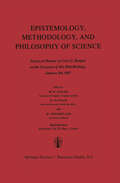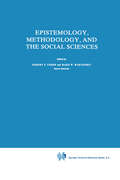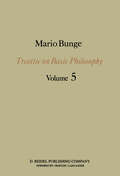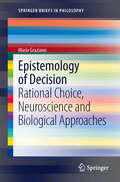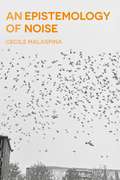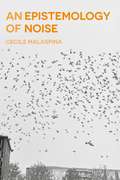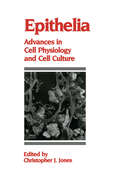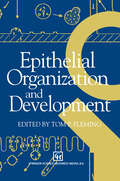- Table View
- List View
Epistemology, Methodology, and Philosophy of Science: Essays in Honour of Carl G. Hempel on the Occasion of His 80th Birthday, January 8th 1985
by Wilhelm K. Essler H. Putnam W. StegmüllerProfessor C. G. Hempel (known to a host of admirers and friends as 'Peter' Hempel) is one of the most esteemed and best loved philosophers in the If an Empiricist Saint were not somewhat of a Meinongian Impos world. sible Object, one might describe Peter Hempel as an Empiricist Saint. In deed, he is as admired for his brilliance, intellectual flexibility, and crea tivity as he is for his warmth, kindness, and integrity, and does not the presence of so many wonderful qualities in one human being assume the dimensions of an impossibility? But Peter Hempel is not only possible but actual! One of us (Hilary Putnam) remembers vividly the occasion on which he first witnessed Hempel 'in action'. It was 1950, and Quine had begun to attack the analytic/synthetic distinction (a distinction which Carnap and Reichenbach had made a cornerstone, if not the keystone, of Logical Em piricist philosophy). Hempel, who is as quick to accept any idea that seems to contain real substance and insight as he is to demolish ideas that are empty or confused, was one of the first leading philosophers outside of Quine's immediate circle to join Quine in his attack. Hempel had come to Los Angeles (where Reichenbach taught) on a visit, and a small group consisting of Reichenbach and a few of his graduate students were gath ered together in Reichenbach's home to hear Hempel defend the new posi tion.
Epistemology, Methodology, and the Social Sciences (Boston Studies in the Philosophy and History of Science #71)
by Marx W. Wartofsky Robert S. CohenThe last decades have seen major reformations in the philosophy and history of science. What has been called 'post-positivist' philosophy of science has introduced radically new concerns with historical, social, and valuative components of scientific thought in the natural sciences, and has raised up the demons of relativism, subjectivism and sociologism to haunt the once calm precincts of objectivity and realism. Though these disturbances intruded upon what had seemed to be the logically well-ordered domain of the philoso phy of the natural sciences, they were no news to the social sciences. There, the messy business of human action, volition, decision, the considerations of practical purposes and social values, the role of ideology and the problem of rationality, had long conspired to defeat logical-reconstructionist programs. The attempt to tarne the social sciences to the harness of a strict hypothetico deductive model of explanation failed. Within the social sciences, phenome nological, Marxist, hermeneuticist, action-theoretical approaches vied in attempting to capture the distinctiveness of human phenomena. In fact, the philosophy of the natural sciences, even in its 'hard' forms, has itself become infected with the increasing reflection upon the role of such social-scientific categories, in the attempt to understand the nature of the scientific enterprise.
Epistemology & Methodology I: Exploring the World (Treatise on Basic Philosophy #5)
by M. BungeIn this Introduction we shall state the business of both descriptive and normative epistemology, and shall locate them in the map oflearning. This must be done because epistemology has been pronounced dead, and methodology nonexisting; and because, when acknowledged at all, they are often misplaced. 1. DESCRIPTIVE EPISTEMOLOGY The following problems are typical of classical epistemology: (i) What can we know? (ii) How do we know? (iii) What, if anything, does the subject contribute to his knowledge? (iv) What is truth? (v) How can we recognize truth? (vi) What is probable knowledge as opposed to certain knowledge? (vii) Is there a priori knowledge, and if so of what? (viii) How are knowledge and action related? (ix) How are knowledge and language related? (x) What is the status of concepts and propositions? In some guise or other all of these problems are still with us. To be sure, if construed as a demand for an inventory of knowledge the first problem is not a philosophical one any more than the question 'What is there?'. But it is a genuine philosophical problem if construed thus: 'What kinds of object are knowable-and which ones are not?' However, it is doubtful that philosophy can offer a correct answer to this problem without the help of science and technology. For example, only these disciplines can tell us whether man can know not only phenomena (appearances) but also noumena (things in themselves or self-existing objects).
Epistemology of Decision: Rational Choice, Neuroscience and Biological Approaches (SpringerBriefs in Philosophy)
by Mario GrazianoThis book carries out an epistemological analysis of the decision, including a critical analysis through the continuous reference to an interdisciplinary approach including a synthesis of philosophical approaches, biology and neuroscience. Besides this it represents the analysis of causality here seen not from the formal point of view, but from the "embodied" point of view.
An Epistemology of Noise: From Information Entropy To Normative Uncertainty
by Cecile Malaspina Ray BrassierWhat do we understand 'noise' to be? The term 'noise' no longer suggests only aesthetic judgement, as in acoustic or visual noise, and is now relevant to domains as varied as communication theory, physics and biology. This trans-disciplinary usage leads to confusion and complication, and reveals that the question of noise is a properly philosophical problem. Presenting an analysis of the rising interest in the notion of noise, this book investigates if there can be a coherent understanding of what it is, that can be effectively shared among the natural and human sciences, technology and the arts. Drawing the philosophical consequences of noise for the theory of knowledge, Malaspina undertakes a philosophical revaluation of Shannon and Weaver's theory of 'information entropy'; this forms the basis upon which to challenge the common idea that noise can be reduced to notions of error, disorder or disorganization. The wider consequences of this analysis relate the technological and scientific aspect of noise, with its cultural and psycho-social aspects. At the heart of Malaspina's argument is the contestation of the ground upon which we judge and distinguish noise from information and finally the exploration of its emancipatory potential.
An Epistemology of Noise: From Information Entropy To Normative Uncertainty
by Cecile Malaspina Ray BrassierWhat do we understand 'noise' to be? The term 'noise' no longer suggests only aesthetic judgement, as in acoustic or visual noise, and is now relevant to domains as varied as communication theory, physics and biology. This trans-disciplinary usage leads to confusion and complication, and reveals that the question of noise is a properly philosophical problem. Presenting an analysis of the rising interest in the notion of noise, this book investigates if there can be a coherent understanding of what it is, that can be effectively shared among the natural and human sciences, technology and the arts. Drawing the philosophical consequences of noise for the theory of knowledge, Malaspina undertakes a philosophical revaluation of Shannon and Weaver's theory of 'information entropy'; this forms the basis upon which to challenge the common idea that noise can be reduced to notions of error, disorder or disorganization. The wider consequences of this analysis relate the technological and scientific aspect of noise, with its cultural and psycho-social aspects. At the heart of Malaspina's argument is the contestation of the ground upon which we judge and distinguish noise from information and finally the exploration of its emancipatory potential.
Epistemology of the Cell: A Systems Perspective on Biological Knowledge (IEEE Press Series on Biomedical Engineering #35)
by Edward R. Dougherty Michael L. Bittner"Honorable mention – Biomedicine and Neuroscience, 2011 Prose Awards" An examination of how the cell should be described in order to effectively process biological data "The fruitful pursuit of biological knowledge requires one to take Einstein's admonition [on science without epistemology] as a practical demand for scientific research, to recognize Waddington's characterization of the subject matter of biology, and to embrace Wiener's conception of the form of biological knowledge in response to its subject matter. It is from this vantage point that we consider the epistemology of the cell."—from the Preface In the era of high biological data throughput, biomedical engineers need a more systematic knowledge of the cell in order to perform more effective data handling. Epistemology of the Cell is the first authored book to break down this knowledge. This text examines the place of biological knowledge within the framework of science as a whole and addresses issues focused on the specific nature of biology, how biology is studied, and how biological knowledge is translated into applications, in particular with regard to medicine. The book opens with a general discussion of the historical development of human understanding of scientific knowledge, the scientific method, and the manner in which scientific knowledge is represented in mathematics. The narrative then gets specific for biology, focusing on knowledge of the cell, the basic unit of life. The salient point is the analogy between a systems-based analysis of factory regulation and the regulation of the cell. Each chapter represents a key topic of current interest, including: Causality and randomness Translational science Stochastic validation: classification Stochastic validation: networks Model-based experimentation in biology Epistemology of the Cell is written for biomedical researchers whose interests include bioinformatics, biological modeling, biostatistics, and biological signal processing.
Epistemology of the Cell: A Systems Perspective on Biological Knowledge (IEEE Press Series on Biomedical Engineering #36)
by Edward R. Dougherty Michael L. Bittner"Honorable mention – Biomedicine and Neuroscience, 2011 Prose Awards" An examination of how the cell should be described in order to effectively process biological data "The fruitful pursuit of biological knowledge requires one to take Einstein's admonition [on science without epistemology] as a practical demand for scientific research, to recognize Waddington's characterization of the subject matter of biology, and to embrace Wiener's conception of the form of biological knowledge in response to its subject matter. It is from this vantage point that we consider the epistemology of the cell."—from the Preface In the era of high biological data throughput, biomedical engineers need a more systematic knowledge of the cell in order to perform more effective data handling. Epistemology of the Cell is the first authored book to break down this knowledge. This text examines the place of biological knowledge within the framework of science as a whole and addresses issues focused on the specific nature of biology, how biology is studied, and how biological knowledge is translated into applications, in particular with regard to medicine. The book opens with a general discussion of the historical development of human understanding of scientific knowledge, the scientific method, and the manner in which scientific knowledge is represented in mathematics. The narrative then gets specific for biology, focusing on knowledge of the cell, the basic unit of life. The salient point is the analogy between a systems-based analysis of factory regulation and the regulation of the cell. Each chapter represents a key topic of current interest, including: Causality and randomness Translational science Stochastic validation: classification Stochastic validation: networks Model-based experimentation in biology Epistemology of the Cell is written for biomedical researchers whose interests include bioinformatics, biological modeling, biostatistics, and biological signal processing.
Epitaktische Schichten: 233. Sitzung am 1. April 1992 in Düsseldorf (Rheinisch-Westfälische Akademie der Wissenschaften #N 410)
by Hartmut ZabelEpitaxial Graphene on Silicon Carbide: Modeling, Characterization, and Applications
by Gemma Rius Philippe GodignonThis is the first book dedicated exclusively to epitaxial graphene on silicon carbide (EG-SiC). It comprehensively addresses all fundamental aspects relevant for the study and technology development of EG materials and their applications, using quantum Hall effect studies and probe techniques such as scanning tunneling microscopy and atomic resolution imaging based on transmission electron microscopy. It presents the state of the art of the synthesis of EG-SiC and profusely explains it as a function of SiC substrate characteristics such as polytype, polarity, and wafer cut as well as the in situ and ex situ conditioning techniques, including H2 pre-deposition annealing and chemical mechanical polishing. It also describes growth studies, including the most popular characterization techniques, such as ultrahigh-vacuum, partial-pressure, or graphite-cap sublimation techniques, for high-quality controlled deposition. The book includes relevant examples on synthesis and characterization techniques as well as device fabrication processing and performance and complements them with theoretical modeling and simulation studies, which are helpful in the fundamental comprehension of EG-SiC substrates and their potential use in electronic applications. It addresses the fundamental aspects of EG-SiC using quantum Hall effect studies as well as probe techniques, such as scanning tunneling microscopy or atomic resolution imaging based on transmission electron microscopy. It comprises chapters that present reviews and vision on the current state of the art of experts in physics, electronic engineering, materials science, and nanotechnology from Europe and Asia.
Epitaxial Graphene on Silicon Carbide: Modeling, Characterization, and Applications
by Gemma Rius Philippe GodignonThis is the first book dedicated exclusively to epitaxial graphene on silicon carbide (EG-SiC). It comprehensively addresses all fundamental aspects relevant for the study and technology development of EG materials and their applications, using quantum Hall effect studies and probe techniques such as scanning tunneling microscopy and atomic resolution imaging based on transmission electron microscopy. It presents the state of the art of the synthesis of EG-SiC and profusely explains it as a function of SiC substrate characteristics such as polytype, polarity, and wafer cut as well as the in situ and ex situ conditioning techniques, including H2 pre-deposition annealing and chemical mechanical polishing. It also describes growth studies, including the most popular characterization techniques, such as ultrahigh-vacuum, partial-pressure, or graphite-cap sublimation techniques, for high-quality controlled deposition. The book includes relevant examples on synthesis and characterization techniques as well as device fabrication processing and performance and complements them with theoretical modeling and simulation studies, which are helpful in the fundamental comprehension of EG-SiC substrates and their potential use in electronic applications. It addresses the fundamental aspects of EG-SiC using quantum Hall effect studies as well as probe techniques, such as scanning tunneling microscopy or atomic resolution imaging based on transmission electron microscopy. It comprises chapters that present reviews and vision on the current state of the art of experts in physics, electronic engineering, materials science, and nanotechnology from Europe and Asia.
Epitaxial Growth of III-Nitride Compounds: Computational Approach (Springer Series in Materials Science #269)
by Takashi Matsuoka Yoshihiro KangawaThis book presents extensive information on the mechanisms of epitaxial growth in III-nitride compounds, drawing on a state-of-the-art computational approach that combines ab initio calculations, empirical interatomic potentials, and Monte Carlo simulations to do so. It discusses important theoretical aspects of surface structures and elemental growth processes during the epitaxial growth of III-nitride compounds. In addition, it discusses advanced fundamental structural and electronic properties, surface structures, fundamental growth processes and novel behavior of thin films in III-nitride semiconductors. As such, it will appeal to all researchers, engineers and graduate students seeking detailed information on crystal growth and its application to III-nitride compounds.
Epitaxie von Metallaufdampfschichten: Zusammenhang zwischen der Epitaxie und den physikalischen Eigenschaften von Wismut- und Eisen-Schichten (Forschungsberichte des Landes Nordrhein-Westfalen #1823)
by Ludwig ReimerUnter Epitaxie versteht man das orientierte Aufwachsen dünner Schichten auf einer kristallinen Unterlage. Im Idealfall erreicht man einkristalline Schichten, welche die Kristallorientierung der Unterlage fortsetzen. Bei der Aufdampf methode muß man in der Regel erhöhte Temperaturen der Unterlage während des Aufdampfprozesses anwenden, um Epitaxie zu erreichen. In vielen Fällen spielen auch Adsorptionsschichten auf den kristallinen Unterlagen eine Rolle. Zum Bei spiel wurde in der vorliegenden Arbeit die Epitaxie von Eisenschichten auf Stein salz-Spaltflächen durch den H 0-Partialdruck begünstigt. 2 Das praktische Interesse an einkristallinen Schichten beruht darauf, daß deren physikalische Eigenschaften besser mit denen des kompakten Materials zu ver gleichen sind als polykristalline Schichten mit regelloser Kristallorientierung, die man beim Aufdampfen auf amorpher Unterlage (Glas oder Kunststoff-Folien) er hält. In der vorliegenden Arbeit sind die Bedingungen untersucht, unter denen ein kristalline Wismut- und Eisen-Aufdampfschichten zu erhalten sind. Wismut zeigt wegen seiner Grenzstellung zwischen Metallen und Halbleitern einen relativ großen Hall-Effekt, der außerdem sehr anisotrop ist und in Abhängigkeit von der Orientierung das Vorzeichen wechseln kann. Den hohen Hall-Koeffizienten kann man zur Messung magnetischer Felder mit Hall-Sonden ausnutzen. Um den Ein fluß einer abnehmenden Schichtdicke auf den Hall-Effekt zu untersuchen, war es erwünscht, auch Messungen an einkristallinen Schichten verschiedener Orien tierung durchzuführen. Ein positives Vorzeichen des Hall-Effektes ist zu erwarten, wenn die (lll)-Ebene parallel zur Schicht liegt und das transversale Magnetfeld in Richtung der trigonalen Achse zeigt. Derartig orientierte Schichten konnten durch Epitaxie auf Glimmer-Spaltflächen erhalten werden.
Epitaxy: Physical Principles and Technical Implementation (Springer Series in Materials Science #62)
by Marian A. Herman W. Richter Helmut SitterIn a uniform and comprehensive manner the authors describe all the important aspects of the epitaxial growth processes of solid films on crystalline substrates, e.g. processes in which atoms of the growing film mimic the arrangement of the atoms of the substrate. Emphasis is put on sufficiently fundamental and unequivocal presentation of the subject in the form of an easy-to-read review. A large part of this book focuses on the problems of heteroepitaxy. The most important epitaxial growth techniques which are currently widely used in basic research as well as in manufacturing processes of devices are presented and discussed in detail.
Epitaxy of Nanostructures (NanoScience and Technology)
by Vitaly Shchukin Nikolai N. Ledentsov Dieter BimbergThe main focus of the book are the physical mechanisms behind the spontaneous formation of ordered nanostructures at semiconductor surfaces. These mechanisms are at the root of recent breakthroughs in advanced nanotechnology of quantum-wire and quantum-dot fabrication. Generic theoretical models are presented addressing formation of all basic types of nanostructures, including periodically faceted surfaces, arrays of step-bunches of equal heights and single- and multi-sheet arrays of both 2- and 3-D strained islands. Decisive experiments on both structural and optical characterization of nanostructures are discussed to verify theoretical models and link them to practical examples.
Epitaxy of Semiconductors: Physics and Fabrication of Heterostructures (Graduate Texts in Physics #4)
by Udo W. PohlThe extended and revised edition of this textbook provides essential information for a comprehensive upper-level graduate course on the crystalline growth of semiconductor heterostructures. Heteroepitaxy is the basis of today’s advanced electronic and optoelectronic devices, and it is considered one of the most important fields in materials research and nanotechnology. The book discusses the structural and electronic properties of strained epitaxial layers, the thermodynamics and kinetics of layer growth, and it describes the major growth techniques: metalorganic vapor-phase epitaxy, molecular-beam epitaxy, and liquid-phase epitaxy. It also examines in detail cubic and hexagonal semiconductors, strain relaxation by misfit dislocations, strain and confinement effects on electronic states, surface structures, and processes during nucleation and growth. Requiring only minimal knowledge of solid-state physics, it provides natural sciences, materials science and electrical engineering students and their lecturers elementary introductions to the theory and practice of epitaxial growth, supported by references and over 300 detailed illustrations. In this second edition, many topics have been extended and treated in more detail, e.g. in situ growth monitoring, application of surfactants, properties of dislocations and defects in organic crystals, and special growth techniques like vapor-liquid-solid growth of nanowires and selective-area epitaxy.
Epitaxy of Semiconductors: Introduction to Physical Principles (Graduate Texts in Physics)
by Udo W. PohlIntroduction to Epitaxy provides the essential information for a comprehensive upper-level graduate course treating the crystalline growth of semiconductor heterostructures. Heteroepitaxy represents the basis of advanced electronic and optoelectronic devices today and is considered one of the top fields in materials research. The book covers the structural and electronic properties of strained epitaxial layers, the thermodynamics and kinetics of layer growth, and the description of the major growth techniques metalorganic vapor phase epitaxy, molecular beam epitaxy and liquid phase epitaxy. Cubic semiconductors, strain relaxation by misfit dislocations, strain and confinement effects on electronic states, surface structures and processes during nucleation and growth are treated in detail. The Introduction to Epitaxy requires only little knowledge on solid-state physics. Students of natural sciences, materials science and electrical engineering as well as their lecturers benefit from elementary introductions to theory and practice of epitaxial growth, supported by pertinent references and over 200 detailed illustrations.
Epithelia: Advances in Cell Physiology and Cell Culture
by C. J. JonesEpithelial cells probably constitute the most diverse group of cells found in the body. In addition to serving as interfaces between external and internal environments, their functions include ion and fluid secretion and reabsorp tion, protein exocytosis, hormone secretion, recognition, surface protection and the control of ciliary movement. By their very exposure on the surfaces of the body, epithelial cells are subjected to wide-ranging assault, by micro organisms and by chemical and physical forces. They are the targets for abrasion, infection and malignant transformation. Some epithelial cells show altered behaviour in inherited syndromes, such as cystic fibrosis, characterized by serious pancreatic and pulmonary disease. In view of the importance of epithelia and the fact that their function can be altered by environmental and inherited factors, they are the subject of intensive research, particularly so in the case of cancer where most tumours are of epithelial origin. The use of animal tissues in epithelial research continues to provide important advances and this, coupled with the need to focus more on human tissues, has prompted a greater research emphasis on accessible human epithelia and on the establishment of cell cultures from animal and human sources. For primary cell cultures and cell lines to be of value, they need to express properties appropriate to their progenitors and relevant to the study in progress.
Epithelial Anion Transport in Health and Disease: The Role of the SLC26 Transporters Family (Novartis Foundation Symposia #273)
by Novartis Foundation StaffCl- absorption and HCO3- secretion are intimately associated processes vital to epithelial function, itself a key physiological activity. Until recently the transporters responsible remained obscure, but a breakthrough occurred with the discovery of the SLC26 transporters family. It is now clear that the SLC26 transporters have broad physiological functions since mutations in several members are linked to a variety of diseases. This book describes the properties of this family in detail, with contributions from the leading global researchers in the field. Complementary views from experts on other ion channels are offered in the discussions, which make fascinating reading. This family consists of at least 10 genes, each of which has several splice variants. Most members of the family are expressed in the luminal membrane of epithelial cells. Characterization of anion transport by three members has revealed that all function as Cl-/HCO3- exchangers, suggesting that SLC26 transporters are responsible for the luminal Cl-/HCO3- exchange activity. The SLC26 transporters are activated by the CF transmembrane conductance regulator and activate it in turn, leading to a model in which these molecules act together to mediate epithelial Cl- absorption and HCO3- secretion. The book includes chapters on the transport of other molecules by the SLC26 family, including oxalate in the kidney and sugars in cochlear hair cells amongst others. It also describes recent discoveries that most SLC26 transporters bind to scaffold proteins and that they all contain a conserved domain predicted to participate in protein-protein interactions. These suggest the SLC26 transporters exist in complexes with other Cl- and HCO3- transporters, and possibly other regulatory proteins. This book explores the functional role of these interactions, leading to better understanding of transepithelial fluid and electrolyte secretion and the diseases associated with it.
Epithelial Cell Culture: Methods and Protocols (Methods in Molecular Biology #1817)
by Mario BarattaThis detailed book explores the most current techniques to study systems and epithelial cell culture. Beginning with an overview, the volume then continues to detail systems that seek to mimic the three-dimensional organization, epithelial cells from different organs, gastrointestinal system, thyroid, salivary gland, ovary, mammary gland, and olfactory epithelial tissue. Cell culture is a fundamental technique in both medical research and drug discovery and two-dimensional (2D) culture has been the preferred method, due to the ease with which cell monolayers can be induced to proliferate on planar surfaces. The book propose several functional assay useful to test cell activities. Further, The past decades have witnessed significant efforts toward the development of three-dimensional (3D) cell cultures. Today, 3D cell cultures are emerging not only as a new tool in early drug discovery, but also as potential therapeutics to treat disease. Written for the highly successful Methods in Molecular Biology series, chapters include the kind of detail and key implementation advice that leads to excellent results in the lab.
Epithelial Cell Culture: Methods and Protocols (Methods in Molecular Biology #2749)
by Mario BarattaBack Cover Copy This second edition volume expands on the previous edition with in-depth discussions on the rapid advancements in epithelial cell biology, and the cutting-edge research and techniques used by researchers in the field. The chapters in this book cover topics such as detailed methodologies applicable to epithelial cells derived from primates, pigs, bovines, and laboratory animals; the manipulation and differentiation of epithelial cells; and epithelial cell models in the gastroenteric system in human medicine and nutrition. Written in the highly successful Methods in Molecular Biology series format, chapters include introductions to their respective topics, lists of the necessary materials and reagents, step-by-step, readily reproducible laboratory protocols, and tips on troubleshooting and avoiding known pitfalls.Comprehensive and cutting-edge, Epithelial Cell Culture: Methods and Protocols, Second Edition is a valuable resource for researchers in the scientific community, educators, and students who are interested in unraveling the complexities of epithelial cell biology, cultivating curiosity, and inspiring the next generation of groundbreaking research.
Epithelial Cell Culture Protocols (Methods in Molecular Biology #945)
by Scott H. Randell and M. Leslie FulcherFascinating biology occurs at epithelial interfaces, whether between organism and environment or within body compartments, and many diseases inflicting huge personal and societal burdens result from dysfunction of epithelial systems, e.g., carcinomas. Epithelial cell cultures have been an integral and crucial part of the biomedical research enterprise, adding unique capabilities and enabling mechanistic approaches. In the past decade there have been many research advances, such as directed differentiation of embryonic stem cells and induced pluripotent stem cells, robotic high throughput screening, whole genome siRNA and shRNA libraries, massively parallel sequencing at low cost, identification of somatic stem cells in key organs, to name a few. Epithelial Cell Culture Protocols, Second Edition provides a cross section of up-to-date culture protocols for the most heavily studied cell systems and featured supporting technologies. Written in the successful Methods in Molecular Biology™ series format, chapters include introductions to their respective topics, lists of the necessary materials and reagents, step-by-step, readily reproducible protocols, and notes on troubleshooting and avoiding known pitfalls. Authoritative and easily accessible, Epithelial Cell Culture Protocols, Second Edition will serve outstanding investigators with the best possible information for the advancement of biomedical science.
Epithelial Organization and Development
by T. P. FlemingEpithelia are one of the commonest tissue types in the animal kingdom. Chapters from leading scientists in the major international research laboratories use examples from different systems to illustrate the form and function of epithelia. An important theme is the way in which epithelial cells differentiate to specialized tissue - reversal of this process occurs when cells become tumorigenic.
Epithelial tissue (Large Print)
by RnibThe image shows the cross section of four types of epithelial tissue. A locator dot and title are shown. These must always be at the top left of the page when the image is the right way up. The four types of epithelial tissue are: 1. squamous 2. cuboidal 3. columnar 4. ciliated Types 1, 2 and 3 may be one layer thick (simple) or multiple layers (stratified). Type 4 is only one layer thick. 1. Squamous: cells are flattened, smooth membrane, found lining heart, blood vessels, lymphatic vessels and alveoli. 2. Cuboidal: cells are cube-like shape, involved with secretion, absorption and excretion, found lining kidney tubules and some glands. 3. Columnar: elongated (rectangular) cells, contain a mixture of cells, some absorb the products of digestion, others secrete mucus (goblet cells, found lining ducts of glands, gall bladder, organs of the alimentary canal. 4. Ciliated:have fine hair-like protrusions called cilia on outer surface, wave-like motion of cilia propel the contents of tubes in one direction, found lining respiratory passages and uterine tubes.
The Epithelial-to Mesenchymal Transition: Methods and Protocols (Methods in Molecular Biology #2179)
by Kyra Campbell Eric TheveneauThis volume details a comprehensive range of methods for imaging epithelial-to-mesechymal transition (EMT)/MET in in vivo systems, and methods to leverage these systems to dissect the underlying mechanisms. Chapters guide readers through studying different features of epithelial-mesenchymal plasticity, past and future research of the EMT, in vivo systems, and in vivo imaging. Written in the highly successful Methods in Molecular Biology series format, chapters include introductions to their respective topics, lists of the necessary materials and reagents, step-by-step, readily reproducible laboratory protocols, and tips on troubleshooting and avoiding known pitfalls. Authoritative and cutting-edge, The Epithelial-to Mesenchymal Transition: Methods and Protocols aims to provide methods in EMT will help to unite and drive research in this exciting field forwards.
